Some notable K-12 Schools in Bhubaneswar – from a Dharitri supplement
1 comment January 31st, 2012
An article in Telegraph mentions that Sainik School Bhubaneswar occupies an area of 220 acres. It is located next to Utkal University in a prime location. At present the Bhubaneswar Sainik School has a capacity of 525 students. Its current faculty strength is 28 and it has an adminsitrative staff of 14. It probably has some more maintenance staff.
While the achievement of Sainik School Bhubaneswar has been very good (see excerpt below)
Achievements: So far approximately 600 cadets have become officers in the defence forces through NDA alone. In addition many cadets have got commission through other entries. This school also has been honoured by the achievements of its cadets through various civil services like IAS-14, IPS-07 and allied services – 09. Several have become ministers in the State of Orissa and Nagaland. The cadets making foray in the fields of medical, engineering, merchant navy are plenty and doing the school proud. The highest ranking officers are two major generals and one Air Vice Marshal.
I think the 220 acres in a prime location in a capital city is a gross under utilization of the land for a residential school of 525 students, 28 teachers and 14 academic staffs, unless one explains it away as a green cover.
Following excerpts tell the story of how the Sainik Schools were set up.
Salient Features of Sainik Schools
(a) The entire capital expenditure on land and buildings is met by the respective State Govts who are also required to provide funds for maintenance of infrastructure and for new infrastructural projects. The State Govts also award scholarships on merit cum means basis.
…
Role of Ministry of Defence in Sainik Schools
(a) Ministry of Defence provides scholarships to wards of defence personnel including ex-servicemen. In addition Ministry of Defence provides central assistance to those students who are awarded state scholarships. The sharing of expenditure on fees/scholarships among Central Govt, State Govt and parents is decided by the BOG from time to time.
(b) With effect from financial year 2003-04, the Ministry of Defence has implemented a scheme under which burden of fee and dietary charges are being shared between the Ministry of Defence and the parents in the ratio 3 : 1. Under this scheme all boys studying in Sainik Schools get financial assistance of about Rs.9,000 – 10,000 every year. The scheme also provides incentive to boys who join the NDA by refunding.
Achievements of Sainik Schools a) Aims – So far these schools have contributed about 7,000 officers to the three services. Its students today occupy important positions in all spheres of national activities. Since the schools were founded in early 60s, its cadets have now reached the level of Generals in the Army and equivalent Ranks in the Navy and Air Force.
b) Results – These schools send about 130-160 cadets to the NDA every year. As far as CBSE results are concerned the schools are performing creditably. All efforts are on to improve the results qualitatively.
c) Quality Education – In most of the States Sainik Schools are the only residential institutions and that too located in isolated areas. Thus these schools have been able to contribute significantly to development of education in backward areas and also in carrying out backward area educational integration.
Considering that the state government gave the land and buildings to the school and in most states these schools are in isolated areas, I think it may be worth pondering if the:
(a) Sainik School Bhubaneswar should be relocated to a backward area where it can contribute positively to the area and the existing 220 acres be used more productively; perhaps by turning it to a small Knowledge City, say similar to the 381 acres Knowledeg City in Mohali.
OR
(b) augment the current use by using part of the 220 acres of Sainik School Bhubaneswar to establish a military academy or an armed forces medical school or a DRDO lab, etc. to have better land utilization.
There are many examples similar to (b). For example, IISER Pune is established on NCL (National Chemical Laboratory) land.
This may be a good time to ponder about options (a) and (b) as it is reported that:
The 220-acres of land given by the government for the existing Sainik School in Bhubaneswar established in 1962 continues to be under the general administration department of the government.
9 comments December 16th, 2011
Following is an excerpt from a report in Times of India.
… Kendriya Vidyalay Sangathan (KVS) has decided to set up a Zonal Institute of Education and Training (ZIET) in Bhubaneswar. This will be the fifth such institute in the country and will cater to over 350 schools of eastern region as a resource centre for states like Bihar, West Bengal, Orissa, Jharkhand and the northeast states.
"Earlier we had to depend on other ZIETs for the purpose of conducting in-service training, refresher courses, workshop and induction courses and research activities. The ZIET in Bhubaneswar will cater to the need of not only teaching but also non-teaching staff of schools. Besides, it will also help in preparation of model lessons and study material, to plan and propose the new areas and strategies required to be incorporated during the training programme to improve the quality of education," said principal of Kendriya Vidyalaya-1, S K Behura.
The ZIET will temporarily function from KV-I till its own building will be constructed in its permanent KVS building at Bankuala, on the outskirts of the city, Behura said.
ZIET, an autonomous body under the ministry of HRD, would also ensure that the participants are provided training in the areas of subject expertise, communication skills, classroom transaction skills, evaluation skills and student-development skills. It also aims at promoting a positive work culture and attitude among teachers through training and develop a healthy attitude in teachers towards research in school education. …
"Initially ZIET will provide training to KVS staff but later will also help in capacity building of employees of all CBSE schools in the region," Behura added.
The web sites of the existing ZIET are as follows:
September 28th, 2011
Following are excerpts from http://educationworldonline.net/index.php/page-article-choice-more-id-2862.
Among other primary-secondaries which have improved their public image and zoomed into the list of India’s Top 30 day schools are the formerly unranked Mirambika, Delhi (27), DAV, Chandrasekharpur, Bhubaneswar (28) and Bombay International (29).
… Thus further investigation of the national league table reveals that Gitanjali School, Hyderabad (estb.1985) is the No. 1 day school in Hyderabad and the southern state of Andhra Pradesh (pop.85 million), no mean achievement. Likewise the Riverside School, ranked a modest No. 13 nationally is the No. 1 day school of Ahmedabad and the western seaboard state of Gujarat (pop. 60 million); DAV, Chandrasekharpur is the No. 1 day school of Orissa (pop. 42 million); St. John’s High is No.1 in Punjab, and City Montessori, Gomti Nagar, ranked No.50 nationally is Lucknow’s most respected day school and fifth in Uttar Pradesh — India’s most populous state (200 million).
The following article from Sambada mentions couple of other schools from Odisha that are ranked high in the eastern zone. The eastern zone ranked schools are: DAV Chandrasekharpur (2), DAV Bhubaneswar (9), DPS Kalinga (17) and KIIT international school (20).
3 comments September 13th, 2011
Following is from a report in Indian Express.
The proposal to set up new specialized Navodaya Vidyalayas to be termed as ‘Science Magnet’ schools, in collaboration with top R&D institutes, got the go-ahead from the Indian Institutes of Science Education & research (IISER) on Tuesday.
At a meeting with the Human Resource Development (HRD) minister Kapil Sibal, IISER directors said that such schools would allow an integrated approach to science education from school to university level. IISER Thiruvananthapuram director has also committed to helping to provide an enabling environment to students enrolled in these Science Magnet schools. The Planning Commission is also learnt to have accorded, in principal, approval for the proposal.
These specialized Navodaya schools will only cater to students from classes IX to XII and will be set up over the next three years. The idea came up in light of the huge shortage of science graduates and post-graduates in the country and the diminishing interest in core science subjects.
Institutes like IISERs, Indian Institute of Science, National Physical Laboratory, Bhaba Atomic Research Centre, Council for Science & Industrial Research (CSIR) will be approached to help these schools which will be located in close proximity to these R&D institutes.
Initially I misread and thought that the IISERs agreed to have science magnet schools in their campus. The above report just says that they agree to the concept. Related reports say that they agree to accept students with IB (International Baccalaureate) degrees. That is important because the science magnet schools may need to get away from CBSE/ICSE/state-board and have IB so as to have a flexible curriculum that allows more courses in science and mathematics. The standard CBSE/ICSE/state-board does not have that flexibility.
I guess the reason an ok from the IISERs is important is because these schools are targeted to be feeder schools to IISERs.
4 comments September 8th, 2010
Following is an excerpt from a report in Pioneer.
The State capital will soon have two more Kendriya Vidalayas with approval by the Ministry of Human Resource and Kendriya Vidalaya Sangathan at Kalinga Nagar and Pokhariput.
The two schools will be known as Kalinga Nagar KV no -5 and Pokhariput no -6 from class I to V.
The Kalinga Nagar KV will temporarily function in the campus of Unit- 1X and Pohariput KV at the campus of Jagamara Nodal Primary School till the permanent buildings come up at their own sites.
The other Kendriya Vidyalayas in Bhubaneswar are:
Other KV’s in the greater Bhubaneswar-Cuttack-Khurda area are:
With the above mentioned two new KVs in Bhubaneswar (at Kalinganagar and Pokhariput) and two new KVs in Cuttack (Khan Nagar and Mundali) the total number of KVs in Bhubaneswar-Cuttack-Khurda will be 12. (This is not counting the one in Puri.)
Following is an excerpt from another report in Pioneer about a new KV in Jajpur Rd.
The demand for a Central School (Kendriya Vidyalaya) here has been fulfilled and the school would start within a week, said District Collector of Jajpur Pramod Chandra Mohanty at a large gathering at the Jajpur Road Town Hall on the occasion of the Local Self Government Day and the Prativa Puja celebration of the Vyasanagar Municipality on Tuesday.
Senior journalist KC Samal placed the demand for a second Central School in the district at the industrial town of Jajpur Road. The first school was opened at Jajpur Town a few days back.
Chairperson of the Vyasanagar Municipality Bandita Parida, who presided over the meeting, assured the Collector to provide an eight-room building in the Jajpur Road Stadium premises to start the proposed Central School immediately.
2 comments September 2nd, 2010
The following is from http://iiser-admissions.in/marks/ which came from Table 1 of the INSPIRE application form of 2010.
| Board | Class 10 % ( top 1% cut off in 2007) |
Class 12 % (top 1% cut off in 2009) |
| Andhra Pradesh | 91.10 | 82.30 |
| Assam | 77.60 | 73.40 |
| Bihar | 73.20 | 73.40 |
| CBSE | 93.60 | 92.40 |
| Chhattisgarh | 82.50 | 85.00 |
| Goa | 85.80 | 81.80 |
| Gujarat | 86.40 | 77.80 |
| Haryana | 87.00 | 82.60 |
| Himachal Pradesh | 76.30 | 79.40 |
| ICSE | 95.60 | 93.30 |
| Jammu & Kashmir | 84.40 | 79.20 |
| Jharkhand | 78.40 | 67.20 |
| Karnataka | 89.60 | 88.00 |
| Kerala | 93.90 | 91.80 |
| Madhya Pradesh | 85.80 | 82.60 |
| Maharashtra | 80.10 | 83.80 |
| Manipur | 77.00 | 75.80 |
| Meghalaya | 70.50 | 70.60 |
| Mizoram | 86.60 | 68.20 |
| Nagaland | 68.10 | 73.00 |
| Orissa | 81.30 | 76.10 |
| Punjab | 81.30 | 76.70 |
| Rajasthan | 79.10 | 82.40 |
| Tamil Nadu | 90.40 | 94.50 |
| Tripura | 68.80 | 68.80 |
| Uttar Pradesh | 72.50 | 72.60 |
| Uttarakhand | 70.40 | 68.20 |
| Viswa-Bharathi | 93.40 | 95.80 |
| West Bengal | 86.60 | 82.20 |
| This list is taken from the website http://www.inspire-dst.gov.in/Inspire-Advertisement.pdf (2007 class X and 2009 class XII) cut off Table 1. | ||
July 19th, 2010
Following three ads are from Samaja.
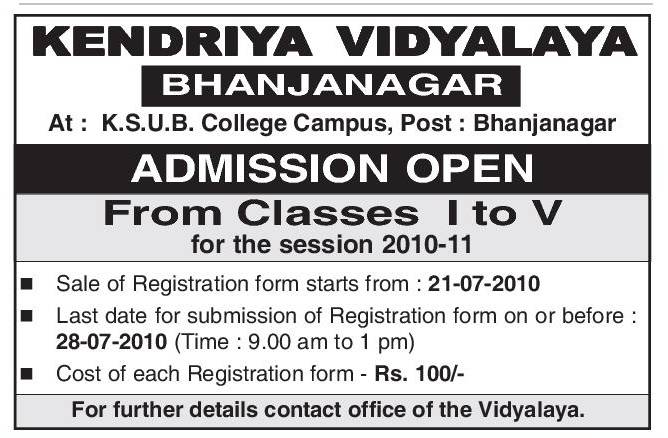
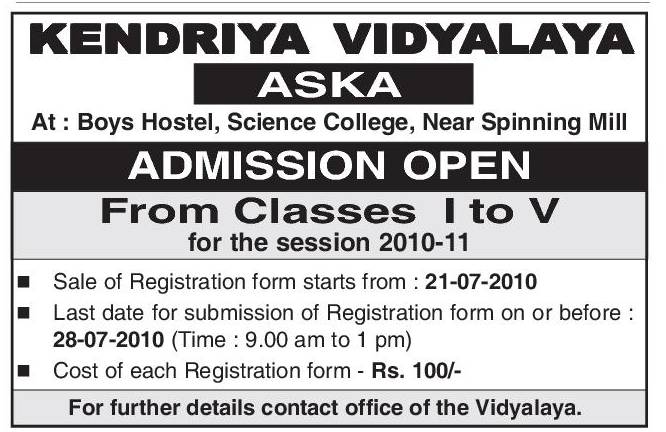
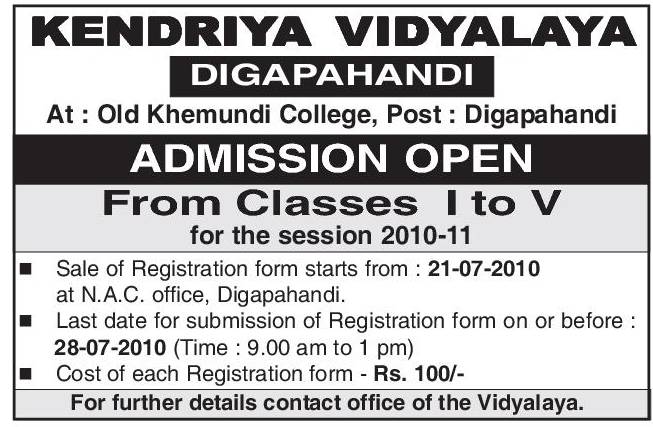
Following is an excerpt from a report in Telegraph.
… two have already started functioning from the Millennium City in Cuttack.
The admission process in the two schools will commence from the current academic session, the notification for which has already been published by the Kendriya Vidyalaya Sangathan (KVS).
The two schools will be operating from Munduli and Nuapatana.
The state government has allotted land for the construction of the two campuses, the work for which has already started.
Before the construction work is completed, the two schools will be operating from the CRPF campus, and from the Government Press.
“Students starting from standard I to V will be admitted now and soon the schools will be upgraded to standard X. Currently, both the schools will have 45 students each,”…
… the remaining nine schools at Kutra in Sundargarh, Bhanjanagar, Digapahandi and Aska in Ganjam, Murgabadi in Mayurbhanj, and one each at Sonepur, Deogarh, Jajpur and Nuapada will be set up soon.
Based on our bookkeeping in https://www.orissalinks.com/archives/4222 after the above schools are established the only two districts in Odisha that will lack a Central School will be: Kendrapada and Nayagarh.
1 comment July 19th, 2010
Update: One day after the news below Samaja also has the following news on 11 new schools.
While some newsreports have been reporting 11 more central schools are coming up (see https://www.orissalinks.com/archives/4818) the following report in Samaja mentions 7 more and the two lists vary. The locations mentioned in Samaja are: Bhubaneswar (2), Cuttack, Nayagarh and Rairangpur. The locations mentioned in Orissadiary are Kutra in Sundargarh district, in Cuttack city, in Bhanjanagar in Ganjam district, in Mayurbhanj town, in Sonepur, in Deogarh, in Jajpur, in Digapahandi of Ganjam District, in Aska of Ganjam district, in Nuapada, in CISF in Cuttack district.
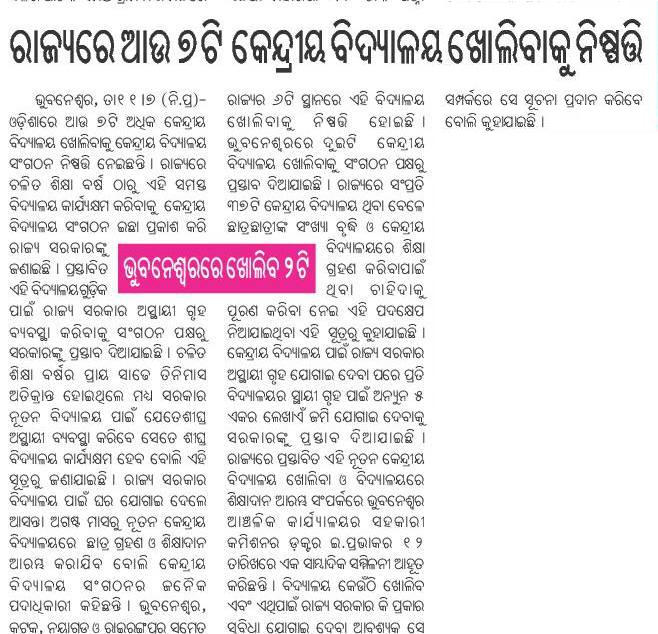
July 13th, 2010
Update 2 on July 12 2010: Orissadiary gives the locations of 11 of the schools.They are:
… one school each in Kutra in Sundargarh district, in Cuttack city, in Bhanjanagar in Ganjam district, in Mayurbhanj town, in Sonepur, in Deogarh, in Jajpur, in Digapahandi of Ganjam District, in Aska of Ganjam district, in Nuapada, in CISF in Cuttack district. Besides, … Prabhakar said.
Update: As per http://www.c2clive.com/latestnewsdetail.php?id=1354 in total Odisha will have 12 new Central Schools. They will be in the districts of Mayurbhanj, Cuttack, Ganjam, Subarnapur, Deogarh, Jajpur, Nuapara and Sundargarh. Earlier in https://www.orissalinks.com/archives/4222 we listed the districts in Odisha that did not have Central Schools. These new schools will cover that list except the district of Kendrapada.
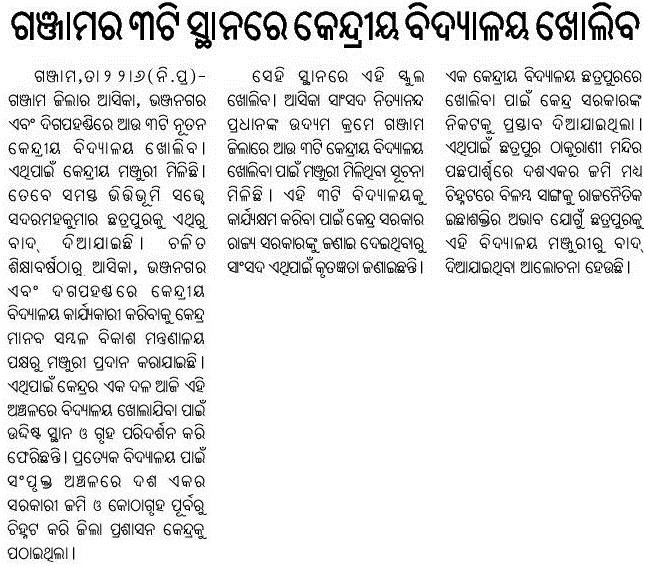
7 comments June 23rd, 2010
The webpage http://www.takshilaschools.in/ mentioned in the ad below is not functional yet. However, a webapge with a similar logo is functional at http://www.takshila.net/. Following is the ad obtained from a report in breakingnewsonline.

2 comments May 12th, 2010
India has several DAV Colleges and Schools. A listing of them can be obtained from http://www.davcmcdircol.org/index2.aspx. Some of their top colleges in India are DAV College Chandigarh and Hansraj College Delhi. They currently have 4 colleges in Odisha.
| 44. | DAV School of Business Management | Unit 8, Bhubneshwar, Orissa – 769004 | 0672-560539(O) |
dsbmbbsr@gmail.com |
Mr. D.N. Mishra |
| 45. | DAV College | Titlagarh, P.O. Bhatipara, Bolangir, Orissa – 767042 | 06655-220523(O), 220344(R), 9437153529(M) | bsnpsar@gmail.com | Shri Bhawani Shankar Negi |
| 46. | Khetrabasi DAV College | Khurda, Nirakarpur, Orissa – 752019 | 06756-222024(O), 9437010336(M) | principal_bkdav@yahoo.com | Shri S. Maharana |
| 47. | DAV Centre for Management Development in Agriculture & Environment | N-4/16, Civil Township, Rourkela, Sundergarh, Orissa – 769004 | 0661-266405(O), 2664724(PP), 9437022010(M) | himansukm@hotmail.com | Dr. H. K. Mohanty |
Based on the claims in their web page, the DAV School of Business Management seems to be doing very well.
Currently there are four DAV Public Schools in the Bhubaneswar area.
There are many DAV Schools in rest of Odisha. This includes
See http://www.adhyapak.com/schools/orissa/orissa_schools2.html for a bigger list.
May 3rd, 2010
Following is an excerpt from a report in Times of India.
The MSC Ed, an integrated six-year course (12 semesters), introduced in 2008 is the right way to master teaching skills. Offering quality teacher education programmes is the Regional Institute of Education that include innovative pre-service and in-service teacher training programmes and relevant research, development and extension activities.
The institute started as Regional College of Education in 1963, changed the name in 1994. It is one of the five such institutions established by the National Council of Education Research and Training (NCERT), New Delhi. The other institutes are located at Ajmer, Bhopal, Bhubaneswar and Shilong.
Prior to the six-year course, there was a two-year MSC Ed course for those who had completed BSC Ed, said Regional Institute of Education Principal GT Bhandage. "It had a good response and the students from all over the country would appear for the entrance exam. This course was conceived essentially to meet the demand of the higher secondary level in specific subjects like physics, chemistry and mathematics. Students who have passed out from this course were absorbed by Navodaya and Kendriya Vidyalaya," added Bhandage.
In 2008, MSC Ed course was introduced after completion of II PUC or equivalent. The idea was to catch them young and train them with pedagogic skills and develop adequate content competency crucial to a teacher education programme, said Bhandage.
The six years integrated course is a combination of BSc and MSC. The first four years, students study physics, chemistry and mathematics while in fifth and final year they can choose a specialization subject.
After completion of the course one can get into Higher Secondary Schools or can do research.
… The admissions are made on all India basis through an entrance exam. The selection will be based on the performance in the qualifying exam and entrance exam.
For details log on to www.riemysore.ac.in or call 514515/ 2514095.
RIE Mysore has a website at www.riemysore.ac.in. I have not been able to find a web site for RIE Bhubaneswar. I wonder if RIE Bhubaneswar offers such a course.
Considering the implementation of RTE, there is a big need for more and better trained teachers and educational administrators (headmasters, principals, vice-principals, etc.). To achieve that the government of India should upgrade the RIEs to National Institutes of Education and make them Institutions of National Importance. This will attract the attention of more good students towards a teaching and teaching administration career. The government should incraese the number of seats and number of programs in these institutes and intrdoce programs for creating top-notch Educational administrators.
1 comment April 14th, 2010
Update: Following are excerpts from a follow-up Telegraph report which mentions about the committee’s recommendation to have wide-spread consultations before making the changes.
But it has advised caution in implementing the reforms. The panel has suggested detailed consultations and workshops with the state governments, other top engineering institutions like the National Institutes of Technology, and private universities.
The recommendations of the panel can be fine-tuned based on the outcome of the consultations, the team led by IIT Kharagpur director Damodar Acharya has suggested. The panel is likely to meet soon and may draw up a schedule for the consultations at that meeting.
… At a meeting of the panel in Chennai on March 16 with representatives of state and central school boards, some participants suggested that rural students be given more opportunities than urban students. The participants proposed two attempts for urban students and three for rural students.
The panel and the HRD ministry will also need to convince state governments that the move to end state-specific engineering tests is not against their interests.
Following is an excerpt from a report in Telegraph.
… The panel, appointed by human resource development minister Kapil Sibal, has recommended replacing the four-decade-old IIT-Joint Entrance Examination (JEE) and myriad other engineering entrance examinations with a common test modelled on the US-based scholastic aptitude test (SAT).
The panel has suggested that the IITs accord a 70 per cent weightage to board examination scores in picking students, ..
Scores in the common aptitude test that will replace the IIT-JEE will contribute the remaining 30 per cent weightage in determining which candidates are selected, the panel has recommended.
Unlike the current engineering entrance examinations including the IIT-JEE, the common aptitude test will not have questions on physics, chemistry and math, but will test students’ powers of logical reasoning and communication skills.
If the recommendations are accepted, the IITs will for the first time admit students based more on their board examination marks than on their performance in a special entrance test.
…The minister had announced in February that he was setting up a panel under IIT Kharagpur director Damodar Acharya to study proposed reforms to the IIT-JEE. The panel was appointed in March, with the directors of the IITs in Mumbai, Roorkee and Chennai as the other members.
… The panel has recommended that the government develop a Comprehensive Weighted Performance Index (CWPI) to calculate a student’s overall score based cumulatively on his performance in the board examinations and in the common aptitude test. The report appears principally based on discussions at a meeting held with other government representatives, including Central Board of Secondary Education chairman Vineet Joshi and select state representatives in Chennai on March 16.
The HRD ministry is already working towards a plan to introduce a common high school curriculum in the sciences and math, cutting across the 35 boards — central and state — that govern Indian school education.
The common curriculum would make easier a comparison between the board examination scores of students from schools affiliated to different central and state government boards, Joshi had told the meeting.
The CWPI proposed by the panel is aimed at normalising any differences that remain between difficulty levels of school-leaving examinations under different boards.
There is a big danger that the above approach will make the XIIth exams a high stakes affair and bring it under the microscope with every aspect of it being scrutinized and judged by everyone. Most coaching classes may reinvent themselves and start coaching how to score more marks in the XIIth exam and the proposed SAT type exam. This approach may bring in bias favoring students from families with educated parents. English being a compulsory subject in XIIth, this may put students in rural areas and other areas where English is less used at a disadvantage.
So one has to wait and see how this will pan out.
My guess is if the above idea is adopted, it will go through some changes such as specific types of colleges may be allowed to give different weight to Class XII marks in different subjects. Some may introduce interviews or other tests.
One change that should be made is that when possible specialty branches should not be assigned to most students (say 70-80% in any college/institute) immediately after they join a college/institute after the XIIth. That should be determined after a year in that college/institute based on the performance in that year. This will make the class XII exam less cutthroat and ensure that students after they get into a college/institute continue to give importance to academics.
One alternative idea may to test the proposed idea (of using class XIIth marks) on 50% of the seats for a few years before deciding whether to completely abandon the current approach or not.
7 comments April 14th, 2010
Following is an excerpt from a report in Telegraph:
The association’s board of governors has recommended the feasibility of 78 more Kendriya Vidyalayas (KV) as part of the process initiated by the HRD ministry for expanding the network of such central schools during the 11th plan period. The feasibility report included two KVs in Cuttack along with nine others across Orissa to address the educational needs of children of central government employees who are frequently transferred.
At present, there are 36 KVs in Orissa. While nine schools are in the project and defence sectors, the rest are in the civil sector.
The existing 36 Kendriya Vidyalayas are listed in http://kvsrobbs.org/DirectorKVs.html. As per that list the latest ones established in 2007 are in Rayagada, Parlakhemundi, Boudh, Malkangiri, Nawrangpur, Kandhamal, and Bhadrak. So the districts in Odisha that do not yet have Central Schools are:
I hope the new ones will cover these districts.
See our earlier articles on this topic at https://www.orissalinks.com/archives/556, https://www.orissalinks.com/archives/550 and https://www.orissalinks.com/archives/227.
1 comment April 9th, 2010
Update: Apparently the MHRD people driving this project have told the HRD minister regarding the origin of the idea behind this proposal and Odisha is in their initial list of locations for one of the 10 schools.
See http://www.indianexpress.com/news/Science-Magnet-Navodayas-soon/597429 and http://www.telegraphindia.com/1100330/jsp/nation/story_12280434.jsp for details. Following are excerpts from the Indian Express article.
… a new set of Navodayas will come up as ‘Science Magnet’ schools in collaboration with top-notch R&D institutes like the Indian Institute of Science, Bhaba Atomic Research Centre, National Physical Laboratory, Council for Science & Industrial Research, Indian Space Research Organisation and the IITs among others, highly placed sources told The Indian Express. Following them will be special schools focused on culture, music, sports and vocational education.
These specialised schools will, however, only cater to students from classes IX to XII. All other Navodaya schools admit students from Class VI onwards.
Starting this year, the schools will be set up over the next three years and add to the chain of over 560 Navodayas spread across the country. Cleared last week by the Navodaya Vidyalaya Samiti’s Executive Committee headed by HRD Minister Kapil Sibal, the proposal is set to go to the Union Cabinet and will take off with 10 Science Magnet Navodayas to start with.
“The whole concept has been developed in view of the huge shortage of Science graduates and post-graduates worldwide. No one wants to do core Science any longer. So planned as a Phase II of the Navodaya expansion, 10 Science Magnet Navodaya schools will be set up at a cost of some Rs 15-20 crore each,” a senior official in the HRD Ministry said. “These will be located in the vicinity of institutes like NPL, BARC, ISRO, IISc etc with whom we will be collaborating. We have already written to these institutes.”
“These institutes will basically do the handholding for the specialised schools, conduct special sessions, help set up state-of-the-art labs, assist in making Science teaching easy, evolve new pedagogical methods and also help to project the basic sciences as attractive options,” added the official. “It is hoped that students will ultimately also plug the vacuum in the scientific community and join their league at these institutes.”
While the course will be based on CBSE curriculum, the admission to these schools will take into account aptitude in Sciences, participation in events like Science Olympiads among other criteria. Admissions to the Navodayas are on the basis of a national-level examination.
We had written about this in https://www.orissalinks.com/archives/303 and had contacted the SAC-PM, DST, IISER/NISER directors, and MHRD officers about it. We are happy that it is now going to be implemented. Hopefully, one of the 10 schools will be in Odisha.
March 30th, 2010
| M | T | W | T | F | S | S |
|---|---|---|---|---|---|---|
| 1 | 2 | 3 | 4 | 5 | 6 | |
| 7 | 8 | 9 | 10 | 11 | 12 | 13 |
| 14 | 15 | 16 | 17 | 18 | 19 | 20 |
| 21 | 22 | 23 | 24 | 25 | 26 | 27 |
| 28 | 29 | 30 | ||||